Parameters of Motion-
We have discussed, the motion of a body may be described through the following parameters-
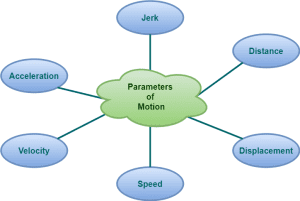
- Distance
- Displacement
- Speed
- Velocity
- Acceleration
- Jerk
Before you go through this article, make sure that you have gone through the previous article on Distance & Displacement.
In this article, we will discuss about speed and velocity.
Speed-
|
It is defined as the rate of change of position of a body with time in any direction.
OR It is defined as the rate of change of distance of a body with time. OR It is defined as the distance traveled by a body per unit time. |
Mathematically,
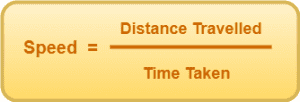
Characteristics of Speed-
- The SI unit of speed is meter per second (m/s).
- The dimensional formula of speed is [LT-1].
- It has only magnitude and no direction. Hence, it is a scalar quantity.
- It can never be negative. It is always positive or zero.
Example On Speed-
Consider a man runs from point A to point B and then back to point C as shown. The total time taken by the man is 100 seconds.

Speed of the man
= Distance traveled / Time Taken
= (AB + BC) / time
= (100+50) / 100
= 1.5 m/s
Different Types of Speed-
There are following 4 different types of speed-
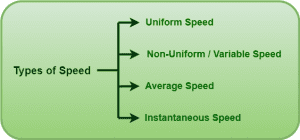
1. Uniform Speed
2. Variable Speed
3. Average Speed
4. Instantaneous Speed
1. Uniform Speed-
A body is said to be moving with uniform speed if it covers equal distances in equal intervals of time, however small these time intervals may be.
2. Variable Speed-
A body is said to be moving with variable speed if it covers unequal distances in equal intervals of time or equal distances in unequal intervals of time.
3. Average Speed-
For a body moving with variable speed, the average speed is defined as the constant speed with which if a body travels, it covers the same distance in same interval of time.
It is given by total distance traveled by the body divided by the total time taken to cover that distance.
Mathematically,

4. Instantaneous Speed-
The speed of a body at any particular instant of time is called as its instantaneous speed.
Suppose a body covers distance Δx in a small time interval Δt, then its average speed is Δx / Δt. The limiting value of this average speed when the time interval Δt approaches zero, gives the instantaneous speed at the instant t.
Thus, Instantaneous speed is given as-
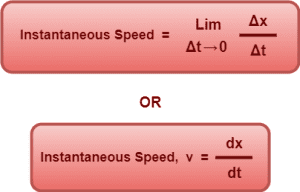
NOTEThe instantaneous speed of a body is equal to the first order derivative of its distance with respect to time. |
The speedometer of an automobile indicates its instantaneous speed at any instant.
Velocity-
|
It is defined as the rate of change of position of a body with time in a given direction.
OR It is defined as the rate of change of displacement of a body with time. OR It is defined as the displacement covered by a body per unit time. |
Mathematically,
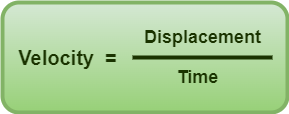
Characteristics of Velocity-
- The SI unit of velocity is meter per second (m/s).
- The dimensional formula of velocity is [LT-1].
- It has both magnitude and direction. Hence, it is a vector quantity.
- The direction of velocity is same as direction of displacement.
- It may be positive, negative or zero.
Example On Velocity-
Consider a man runs from point A to point B and then back to point C as shown. The total time taken by the man is 100 seconds.

Magnitude of velocity of the man
= Displacement / Time
= AC / time
= 50 / 100
= 0.5 m/s
Different Types of Velocity-
There are following 4 different types of velocity-
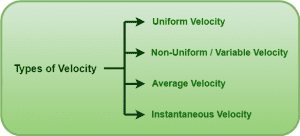
1. Uniform Velocity
2. Variable Velocity
3. Average Velocity
4. Instantaneous Velocity
1. Uniform Velocity-
A body is said to be moving with uniform velocity if it covers equal displacements in equal intervals of time, however small these time intervals may be.
2. Variable Velocity-
A body is said to be moving with variable velocity if either its speed changes or direction of motion changes or both changes with time.
3. Average Velocity-
For a body moving with variable velocity, the average velocity is defined as the constant velocity with which if a body travels, it covers the same displacement in same interval of time.
It is given by total displacement covered by the body divided by the total time taken to cover that displacement.
Mathematically,

4. Instantaneous Velocity-
The velocity of a body at any particular instant of time is called as its instantaneous velocity.
Suppose a body covers displacement Δx in a small time interval Δt, then its average velocity is Δx / Δt. The limiting value of this average velocity when the time interval Δt approaches zero, gives the instantaneous velocity at the instant t.
Thus, Instantaneous velocity is given as-
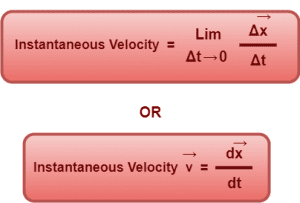
NOTEThe instantaneous velocity of a body is equal to the first order derivative of its displacement with respect to time. |
Differences Between Speed & Velocity-
The following table shows the differences between speed and velocity-
Speed |
Velocity |
| It is rate of change of distance. | It is rate of change of displacement. |
| It is a scalar quantity. | It is a vector quantity. |
| It can never be negative. It is always positive or zero. | It may be positive, negative or zero. |
| It does not give any idea about the direction of motion of the body. | It gives an idea about speed as well as direction of motion of the body. |
Read the next article on-
Get more notes and other study material of Motion in One Dimension.

